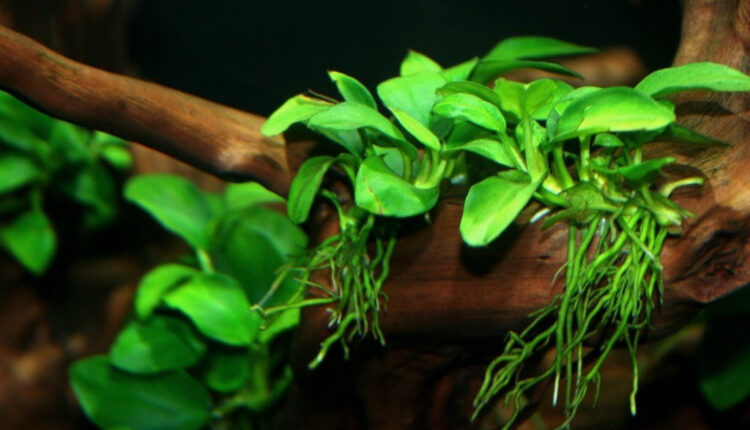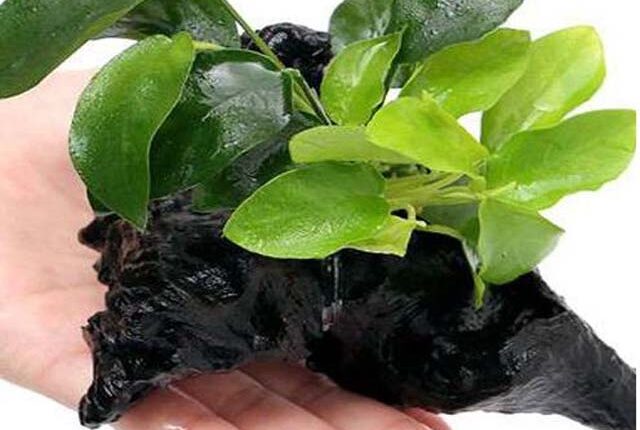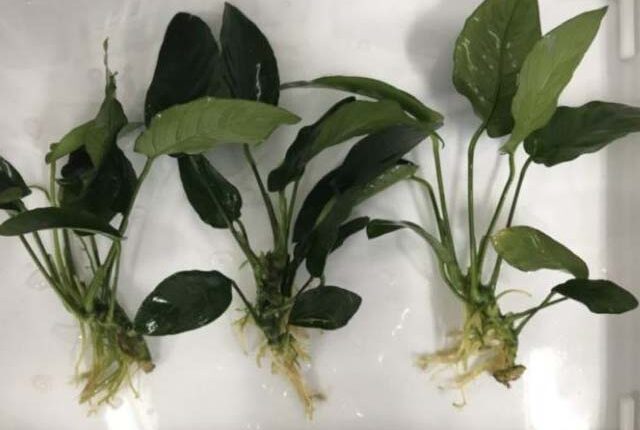Anubias Nana: A Complete Growing Guide

Anubias Nana is a typical type of introduction to aquatic plants. Since it is easy to grow, it is a waterweed that is always introduced as a waterweed for beginners in any book. This time, we will introduce the features of Anubias Nana, how to make it take root in driftwood and stones, how to divide the stock when increasing it, and how to grow Anubias Nana with photos.
Features of Anubias Nana
It is a rosette-shaped aquatic plant that grows naturally in Africa (leaves radiate from the center), and is often used for driftwood layout because it has the property of rooting in driftwood and rocks and taking root. It is a popular type of aquatic plant for beginners, and it is almost always introduced as aquatic plants for beginners. If you are an aquarium shop that sells aquatic plants, you can find it anywhere. (At least I haven’t seen a shop that I haven’t put it in.)
Anubias Nana is a waterweed with green oval round leaves that is about 10 cm in size and about 4 to 5 cm in length. Since it is a negative plant like willow moss and microsolium, which are famous for beginners of aquatic plants, it does not require a strong amount of light and can be laid out in the shadow of background grass or driftwood without any problem. It is a very durable type that does not require light intensity or CO2 addition and can be applied to a wide range of water qualities.
Even if the bottom floor is not soil, it can be grown on other bottom floors such as gravel and lava stone, so it is often used from full-scale aquatic plant layout aquariums to tropical fish tanks that are mainly living organisms and are placed with a slight accent… No CO2 addition is required, but it will grow faster.
As a layout usage, because it grows even in the shadows, it can be placed in the shadow of driftwood or background grass, or it can be placed as an accent in places where you want to draw attention by taking advantage of the characteristic leaf shape. You can lay out anywhere depending on your ideas. It is not necessary to bury it in soil, so if you let it settle on a small stone and submerge it, you can freely change the arrangement according to your mood, so it is recommended to settle on a small stone or driftwood. Also, since it grows slowly, it is easy to be damaged by moss, but if you let it settle on a small stone, you can take it out of the aquarium and apply wood vinegar directly.
In addition, there are dozens of items in circulation that have the name Anubias, and it is also attractive that they are highly collectible.
The following points are recommended for beginners.
- No need for high light intensity
- No need to add CO2
- Not noisy with water quality
- Easy to use for layout
- Slow growth means you won’t be overwhelmed by trimming
Appearance
It has dark green round leaves. The stems and leaves are solid and thick, so it doesn’t feel like swaying in water.
The size is about 10 cm, and the size of the leaves is 3-4 cm.
Below, I will mainly explain Anubias Nana, but there are many types of Anubias, large ones, small ones, thin leaves, strangely shaped leaves, variegated leaves. There are various things such as what you have.
Grows without shade or carbon dioxide addition
One of the reasons why Anubias Nana is recommended is that it is ”durable“.
It is okay in the shade where other aquatic plants cannot grow, and there is no need to add carbon dioxide. However, of course, since it is a plant, it grows by photosynthesis. It grows faster with the right amount of light and carbon dioxide.
It can grow on soil and gravel and grow on driftwood
Anubias Nana is a really tough, hands-free aquatic plant that can be planted anywhere. It can grow normally on soil and gravel, and can also be used on driftwood and rocks.
The aquatic plants that have settled on driftwood and rocks create an indescribable natural atmosphere. Moreover, if it is attached to driftwood, it is very easy to manage because the driftwood can be taken out when you want to wash soil or gravel or when you need to trim it. Please try it!
Slow growth eliminates the need for frequent trimming
It grows more slowly than other aquatic plants. Some people may be disappointed when they hear that “growth is slow”, but the opposite is true depending on the way of thinking.
At first, I felt that way and introduced fast-growing aquatic plants, but because they grew too much, the layout inside the aquarium changed unexpectedly quickly. Only some aquatic plants were overgrown, obscuring other aquatic plants.
If this happens, you will need to trim (cut the aquatic plants with scissors, etc.) and replant. If it’s fun, there’s no problem, but for the author who was a beginner in aquatic plants, it was a burden, and I had the image that ”growth is slow = care is easy“.
Anubias Nana grows slowly so it’s easy to take care of.
Anubias Nana Petite Durable aquatic plant with round green leaves
Feature
Anubias Nana Petite is an improved variety of Anubias Nana. The length of the leaves is about 1.5 cm to 3.5 cm, and the round green leaves are cute aquatic plants. Anubias is a negative plant that grows very slowly and is an easy-to-manage aquatic plant. In the layout, it is used by rooting on driftwood and stones. The aquarium size is suitable for a wide range of layouts from small aquariums to large aquariums. Since it is smaller than Anubias Nana, it is easier to get a sense of scale in the aquarium if Anubias Nana Petite is densely grown in the layout. It is an aquatic plant that is widely distributed and easy to purchase.
How to grow
Anubias Nana Petit is a slow-growing aquatic plant that you want to grow slowly. We prefer weakly acidic to neutral water quality. It can be grown without CO2, but adding CO2 is effective for growing beautifully. The growth speed is proportional to the amount of leaves. Strains with many leaves develop faster shoots, while those with few leaves grow very slowly. Anubias Nana Petite is wrapped around driftwood and stones to survive and grow. It is often sold in a pot, and when you put it in an aquarium, you take it out of the pot and wrap it around driftwood or stone to use it for layout. The photo is wrapped around a 1 to 6 cm wind mountain stone.
How to trim and increase
In order to increase Anubias Nana Petite, it is important to have an aquarium environment where you can slowly grow in a moss-resistant aquarium. Trimming cuts from overgrown or old leaves. Also, if the stock becomes too large, we will cut the overgrown or overgrown stock. The way to increase is to expand the leaves so that the stock grows and increases.
Withers and melts
Since it is a very strong aquatic plant, it rarely melts even if it is covered with moss. Even if ordinary aquatic plants are cut with moss, if the occurrence of moss is improved, it is possible to remove the moss with Yamatonuma shrimp or shellfish and restore it to beautiful leaves. It may die in an extremely cold environment such as winter or due to stress during transportation. Also, if there are old leaves or damaged leaves, they will die. Even if the leaves die, if the plants have not melted, they will regenerate, so place the plants on the bottom floor or driftwood and wait for the shoots to develop slowly.
Comparison with normal Anubias Nana
Normal Anubias Nana leaves are 3 to 5 cm, while Petit is 1.5 to 3.5 cm, which is about twice as small as Anubias. The growing method and difficulty level do not change, but the impression of growing is that the petite at the time of purchase has more leaves, so it grows faster than normal Nana. It is an aquatic plant that is easy to use for layout because the leaves are smaller than normal Nana.
There is also a light green “golden”
In this image, Anubias Nana and Anubias Nana Golden are planted together, so it is easy to see the difference in color.
If you want to brighten the inside of the aquarium, Golden is recommended. It is a tough aquatic plant that grows in the same way as ordinary Nana.
Anubias Nana Golden Melts
Anubias Nana Golden and Petit glued to driftwood. Of those, most of Anubias Nana Golden melted in about a week (crying) By the way, Petit Was safe. Anubias Nana is famous for aquatic plants for beginners, so I never thought it would melt. I’m a little upset (sweat) In order not to forget to learn from failure, I researched various things about Anubias Nana, and found that even the basically strong Anubias Nana may melt in rare cases. thing. The root is discolored and is about to melt.
The main causes of Anubias Nana melting are (1) rapid temperature change, (2) bacterial infection from the cut end, (3) purchase of weakened individuals, and (4) planting in soil. These causes are considered. For me. seems to apply. (1) When I bought it at the shop, I bought the one that was already packed in vinyl and was on the wagon, and then put the whole cup into a heated aquarium.
Let’s remove it from the pot
As with any aquatic plant, most aquatic plants are sold in pots.
You can leave it in the pot, but when it grows it can clog the roots, and if rock wool has moss or pesticide residues, it will also be put in the aquarium.
So let’s remove it from the pot first. If you grab the leaf and pull it, the leaf will be damaged, so hold the root and gently pull it out. Then remove the rock wool and wash it clean. If the roots are entwined with rock wool, you can cut the roots.
Let’s divide the stock and plant
Most Anubias Nana for sale have multiple stocks in the pot, so let’s separate them. If left as it is, it may be too crowded to grow well.
Let’s cut out the broken one
The stems and leaves may break when you remove them from the pot, but cut off the broken parts. Since it is a “scratch on a plant”, germs may enter from there and rot may spread throughout Anubias Nana. The same is true if you have old, dull leaves or dark roots.
If the aquatic plants rot, the water quality will also deteriorate, so be careful. To avoid such cases, carefully check the entire plant before planting.
Be careful not to bring in residual pesticides, moss, snails, etc
Anubias Nana grows slowly, so it takes a long time to grow in the shop. Therefore, it is necessary to pay attention to residual pesticides. In addition, there may be a slight amount of moss, or snail eggs may be hidden and attached.
If you bring these things into the aquarium, it’s really hard to get rid of them, so you need to be very careful when you bring new things into the aquarium, not just Anubias Nana.
If you are uncertain, it is safe to use the items below. It is made of 100% natural materials and is domestically produced, so you can use it safely.
Increase by stock split
Anubias Nana grows with its main stem extending laterally. This is a type in which the basic stem grows horizontally, a thin stem with leaves (called a petiole) is attached on top, and roots are attached underneath. In technical terms, it is called a runner, Hofukushi.
It is possible to increase the number of strains steadily by cutting the stem that extends beside it and making it into multiple strains. However, if you cut it with the momentum that you only need to attach about 3 leaves, it will not grow as expected. When dividing the stock, keep the following points in mind.
- Attach 5 or more leaves
- State in which all the leaves, stems, roots aligned to
- It has sprouts and white roots that are likely to grow in the future.
Please plant the new stock increased in this way in the form of soil, gravel, or driftwood.
However, as I mentioned above, Anubias Nana is a slow-growing aquatic plant, so let’s wait patiently for it to grow.
Creating an environment where moss does not grow easily
First of all, let’s create an environment where moss does not grow easily. The conditions under which moss grows easily:
- High in nutrients: When water quality deteriorates, it is easy to become eutrophicated, so change the water properly.
- Amount of light: Direct sunlight on the aquarium is strictly prohibited.
- High in carbon dioxide: It’s difficult to balance if added for aquatic plants.
- Poor filtration capacity: This is also a cause of poor water quality. Change the filter from time to time.
If moss grows, one way is to introduce an organism that eats it. The famous one is the Amano shrimp
A cute shrimp famous for eating moss. I like filamentous moss like Spirogyra, so I recommend it if the type of moss that grows is filamentous.
There is also Otocinclus, which eats moss that grows on the glass surface like a scrape.
Otocinclus feeds on moss-like plants, so when the moss disappears, there is no food. In that case, please feed for Otocinclus or give soft boiled leafy vegetables (Komatsuna and spinach).
There are various other moss-cleaning creatures, so please choose according to your taste and type of moss.
Artificially remove moss
I’m grateful that when you introduce a creature that removes moss, it will be automatically removed, but there are times when the creature does not move as you wish. In such cases, it will still be necessary to remove it manually.
The method is simple, but you can pick it up with tweezers or gently rub it with an old toothbrush.
Another method is to kill the moss with vinegar or wood vinegar. In that case, it feels like taking Anubias Nana completely out of the aquarium and quickly applying the liquid to the moss. Pyroligneous acid is very odorous, so I personally think that vinegar is milder. Vinegar is found in most homes.
However, this is “dangerous”, so please understand it before doing so. Substances that are harmful to moss are harmful to Anubias Nana and to other organisms in the aquarium. After processing, wash it thoroughly and return it to the aquarium so that there is no residue.
Growth is slow and manageable, and the variety of Anubias is a truly popular aquatic plant. We hope you will get along well and enjoy the lively and beautiful aquarium!





